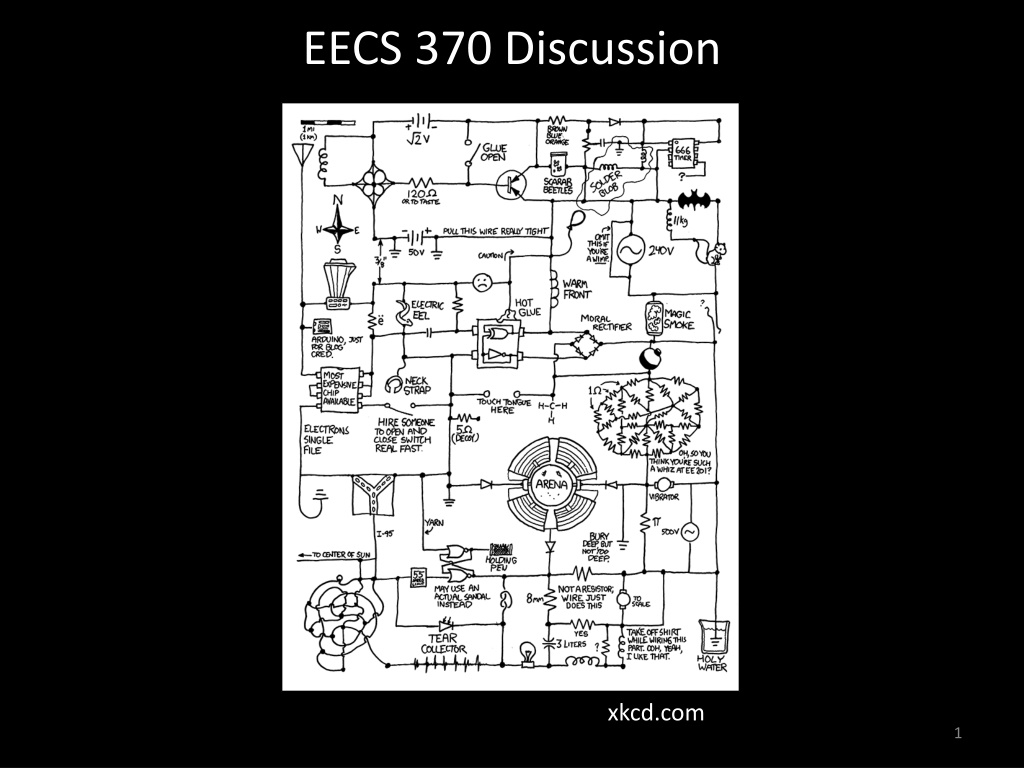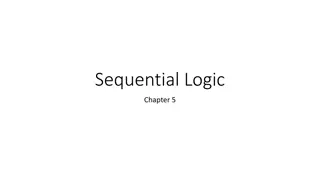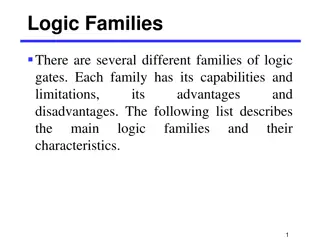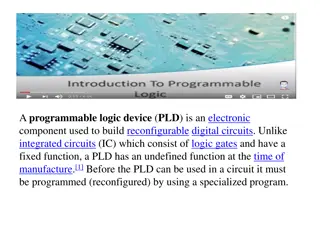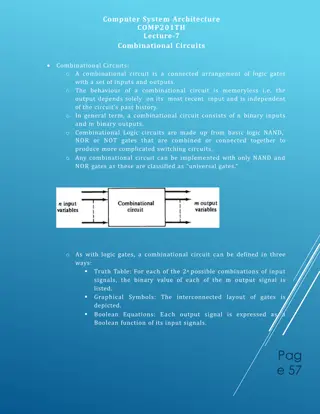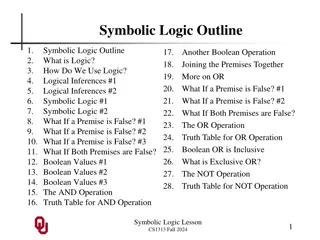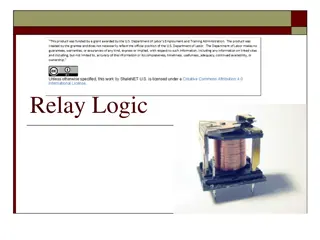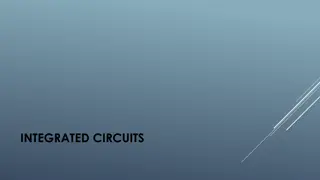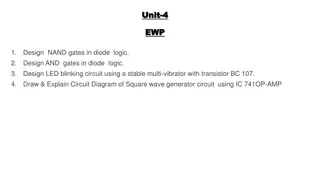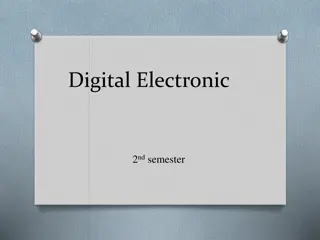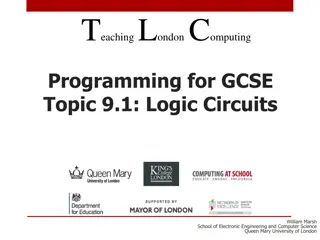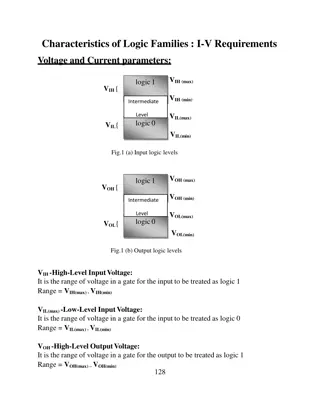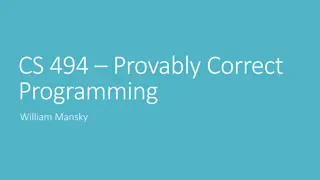Integrated Circuits and Logic Circuits
Integrated circuits (ICs) are made from silicon and contain gates to perform computations. These circuits can vary in complexity, from simple Boolean functions to complex CPUs. Learn about different types of IC packages and how multiplexers, decoders, comparators, and other circuits function in digital logic systems.
Download Presentation

Please find below an Image/Link to download the presentation.
The content on the website is provided AS IS for your information and personal use only. It may not be sold, licensed, or shared on other websites without obtaining consent from the author.If you encounter any issues during the download, it is possible that the publisher has removed the file from their server.
You are allowed to download the files provided on this website for personal or commercial use, subject to the condition that they are used lawfully. All files are the property of their respective owners.
The content on the website is provided AS IS for your information and personal use only. It may not be sold, licensed, or shared on other websites without obtaining consent from the author.
E N D
Presentation Transcript
EECS 370 Discussion xkcd.com 1
EECS 370 Discussion Topics Today: Floating Point Finite State Machines Combinational Logic Sequential Logic 2
EECS 370 Discussion Floating Point Exponent Biased by 127 Significand Additional 1 before the decimal sign 3
EECS 370 Discussion Floating Point Don t forget about zero! 4
EECS 370 Discussion Floating Point Addition -1.1011*(22) + 1.01*(20) 5
EECS 370 Discussion Floating Point Addition -1.1011*(22) + 1.01*(20) = -1.0110*(22) 6
EECS 370 Discussion Floating Point Addition [-6.75] [1.25] -1.1011*(22) + 1.01*(20) = -1.0110*(22) [-5.5] 7
EECS 370 Discussion Floating Point Multiplication [-6.75] [1.25] -1.1011*(22) * 1.01*(20) 8
EECS 370 Discussion Floating Point Multiplication [-6.75] [1.25] -1.1011*(22) * 1.01*(20) = -1.0000111*(23) 9
EECS 370 Discussion Floating Point Multiplication [-6.75] [1.25] -1.1011*(22) * 1.01*(20) = -1.0000111*(23) [-8.4375] 10
EECS 370 Discussion Finite State Machines Diagram of State, Conditions to change state, and Outputs Conditions to change are based on inputs 11
EECS 370 Discussion Finite State Machines Example: Output a 1 on the pattern 001 States: Pattern 1 Pattern 0 Pattern 00 Pattern 001 => Output = 1 12
EECS 370 Discussion Combinational Logic Digital circuit representing a Boolean equation Truth tables!! 13
EECS 370 Discussion Combinational Logic More Complex Circuits: Mux Decoder A0 A1 A Out0 S C Out1 Out2 Out3 B 14
EECS 370 Discussion Combinational Logic More Complex Circuits: Full Adder Half Adder 15
EECS 370 Discussion Combinational Logic More Complex Circuits: Ripple Carry Adder 16
EECS 370 Discussion Combinational Logic Propagation Delay 17
EECS 370 Discussion Combinational Logic Propagation Delay Slows down the speed of your circuit! 18
EECS 370 Discussion Combinational Logic Most Complex Circuits: Carry Look-ahead Adder 19
EECS 370 Discussion Sequential Logic Combinational Logic Stateless Output is direct function of current input Sequential Logic Stateful Output is function of current input and past input Clocked! 20
EECS 370 Discussion Sequential Logic Latches SR Latch D Latch 21
EECS 370 Discussion Sequential Logic Flip Flops Positive Edge Triggered 22
EECS 370 Discussion Sequential Logic Why do we want clocked logic? Specifies a time by which all operations are done Results before that time do not matter 23
AN EXAMPLE OF WHY THIS MATTERS Delays in combinational circuits are very real. Here s an example with a ripple carry adder ripple carry adder.
AN EXAMPLE OF WHY THIS MATTERS Let s zoom in on the interesting part. The value of a goes from 7 to 1 here
AN EXAMPLE OF WHY THIS MATTERS Let s zoom in on the interesting part. There s propagation delay before the adder even starts to change values.
AN EXAMPLE OF WHY THIS MATTERS Let s zoom in on the interesting part. The value stabilizes
AN EXAMPLE OF WHY THIS MATTERS Let s zoom in on the interesting part. The next clock edge comes along
AN EXAMPLE OF WHY THIS MATTERS Let s zoom in on the interesting part. The latch opens up (and shows new value) The flip-flop grabs new value.
AN EXAMPLE OF WHY THIS MATTERS Let s zoom in on the interesting part. B changes now, while the clock is still high.
AN EXAMPLE OF WHY THIS MATTERS Let s zoom in on the interesting part. Again, there s propagation delay before the adder starts to change.
AN EXAMPLE OF WHY THIS MATTERS Let s zoom in on the interesting part. The value in the latch changes too!
AN EXAMPLE OF WHY THIS MATTERS Let s zoom in on the interesting part. The next falling edge comes along
AN EXAMPLE OF WHY THIS MATTERS Let s zoom in on the interesting part. The adder stabilizes.
AN EXAMPLE OF WHY THIS MATTERS Let s zoom in on the interesting part. The latch locked with the wrong value!
